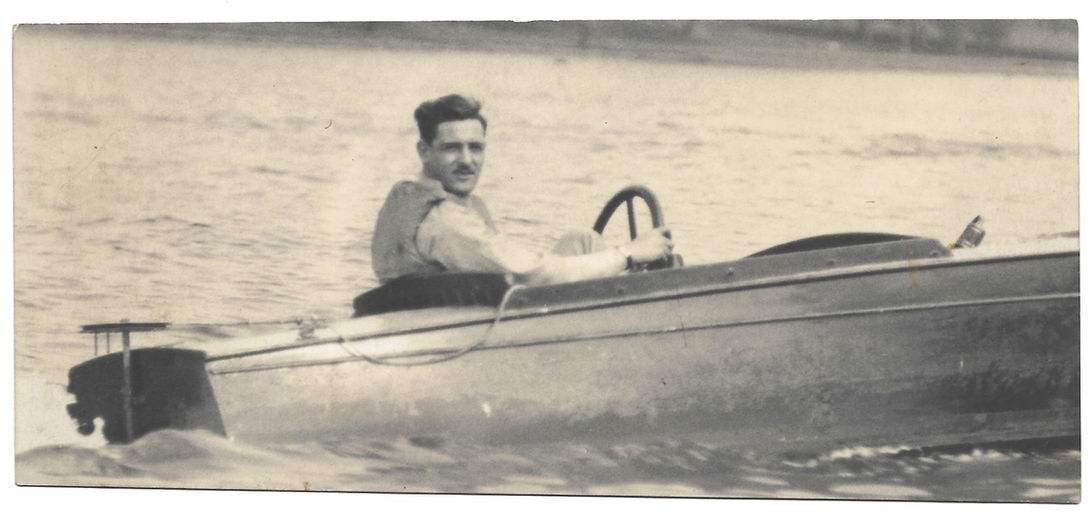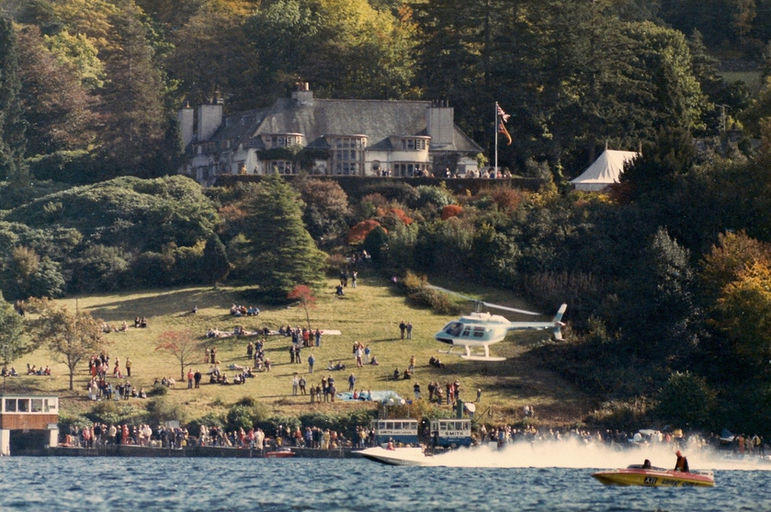Windermere Motor Boat Racing Club
100 years in pictures
We present here a selection of images from our archives which take you on a journey through the history of racing power boats on Windermere
scroll down or click an era

The Early Years
1925 to 1939
Motor boat racing on Windermere traces back to the early 1900s, when motorboat and hydroplane handicap races became a popular feature of the annual Water Carnivals.
Following the Great War, a group of racing enthusiasts came together to formalize the sport, and on October 24, 1925, the Windermere Motor Boat Club (WMBC) was founded.
Initially, the club had 43 members, including women, with a woman winning the first official race. Subscription was set at 3 guineas for gentlemen plus a 2 guinea entrance fee, and 1 guinea for ladies.

The club's first home was a boathouse in Bowness Bay, now home to the Lake District Boat Club. Seeking a more permanent home, members purchased land near The Glebe in 1927 and raised a significant amount of money to build a new clubhouse.
This new clubhouse served the club for a quarter of a century and its three-bay veranda features in many Club photographs.
During this era, racing boats consisted of cabin boats and other launches, and the club held its first interclub race with Chester Motor Boat Club. Races were started with a shotgun until 1939, when a chronometer was introduced. By the end of this period, boat speeds had already reached up to 50 mph.
The 1927 Club House near the Glebe
click photos to expand


Pattinson Family 1930's Cine Film
E.H. Pattinson (Harold) was a founding Member of the Club and Commodore in 1926, 1927, 1928 then again in 1939.
These videos were recently presented to the Club by Harold's Great Niece, Lucy Pattinson
We have restored these videos to full HD
The tiktok generation note these are not 'talkies'
Unloading the Boats
Click to play and full screen icon to expand
Motoring on the Lake
Click to play and full screen icon to expand
Early Years Gallery
click any tile to explore with titles & captions

Post-war Years
1945 to 1969
After the war things gradually returned to normal and three races were held in 1946 where eight boats were ready to race. A few more joined them in 1947 and racing activities were fully established again as petrol rationing gradually eased.
In 1949 against a background of continuing shortages, the Club organised a first International Meeting.
Membership had reached 99, of which 28 were ladies and 32 were boat owners.
With membership growing rapidly and the clubhouse becoming too small, members purchased a new home, Broad Leys, on August 18, 1950.
It was not long after this that the club’s name was changed to the Windermere Motor Boat Racing Club (WMBRC) to emphasize its true purpose.
In October 1951 at its new home the Club hosted a second International Meeting on Lake Windermere.

The 1950s were a golden age of speed for the club. With petrol rationing relaxed, two of the club's boats became among the fastest in Europe, reaching speeds of 70-80 mph with Rolls Royce engines from war aircraft.
In 1956, 12 WMBRC boats had the honor of escorting HM Queen Elizabeth and the Duke of Edinburgh across the lake.
In the 1960s, the style of racing boats changed, with Chris Crafts and hydroplanes being superseded by smaller Albatross boats with aluminium hulls and Coventry Class engines, and later, Deltas with Ford engines. Outboard engines were first allowed in 1965. In 1964, three WMBRC members took part in the Paris Six Hours Enduro on the Seine.
Our new home at Broad Leys since 1950
click any tile to expand this gallery with captions
Post-War Years Gallery
click any tile to explore with titles & captions

The 1970s became synonymous with the introduction of Catamarans and ModVPs (Modified V Production hulls), which were made of fibreglass and allowed for greater speed and maneuverability. From 1971 to 1974, WMBRC hosted an annual Grand Prix with international drivers, an event later moved to the water in front of Broad Leys.
The 1970s also saw the arrival of the rotary engine, with boats reaching speeds of 100 mph on the straight. Due to increased speeds, safety became a key focus, with strict rules on life jackets and helmets enforced under the guidance of the RYA.
Late 20th Century Gallery
click any tile to explore with titles & captions

Modern Times
2000 to 2025
The introduction of a speed limit on Windermere in 2004 saw the move to racing at Barrow for 6 years until a special exemption was made for WMBRC to race again on the lake from 2012.
The temporary relocation to Barrow Docks inspired WMBRC to co-ordinate its club racing with LPRC (Lancashire Powerboat Racing Club) at its home on Carr Mill Dam near St Helens.
Both Clubs now run a combined season of 12 races split between Windermere and Carr Mill Dam.
The racing still has craft as diverse as ever with the lap-time-handicapping system allowing experienced racers and the fastest catamarans to compete alongside the newest drivers and boats.

As the oldest motor boat club in the world still racing, WMBRC remains committed to ongoing innovation. In 2024, the club held its first sustainable race event, with all boats powered by sustainable fuel that delivers a 65% reduction in greenhouse gases compared to fossil fuels. The club has also developed its first all-electric powered racing boat, which took part in Records Week on Coniston.
Modern Times Gallery
click any tile to explore with titles & captions

Future Times
The next 25 years
How to get involved
Want to help shape the next 25 years of history at Windermere Motor Boat Racing Club?
WMBRC encompasses much more than the name suggests!
Owned and run by members, it welcomes prospective members not only to boat racing, but also the wide range of associated social activities at Broad Leys.
If you want to know more - read more about membership of WMBRC
If you have already decided - contact us or complete a membership enquiry form
or contact: membership@wmbrc.co.uk
To find out more about Windermere Motor Boat Racing Club
at Broad Leys including Racing, Sailing and Accommodation at Broad Leys follow the links below.
























































